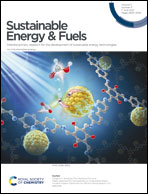The synergistic role of the photosensitivity effect and extended space charge region in an inorganic–organic WO3/PANI photoanode for efficient PEC water splitting†
Abstract
The predicaments of poor carrier separation and light absorption need to be overcome in order to maximize the preeminent performances of WO3 in photoelectrochemical (PEC) water splitting. Hence, we firstly prepared a 2D WO3/PANI core–shell hybrid heterojunction with high light absorption efficiency by a simple hydrothermal and photo-assisted electro-deposition method. A photocurrent density of 0.499 mA cm−2 at 1.23 V vs. RHE is achieved by the as-prepared hybrid heterojunction, which is about 2.35 folds higher than that of bare WO3 (0.212 mA cm−2). Moreover, the PEC stability is significantly enhanced to 87% from 60% with the deposition of organic PANI. PEC and optical measurements demonstrate that the significant PEC properties are attributed to improved photogenerated carrier separation efficiency (ηsep) and injection efficiency (ηinj) as well as broadened light absorption due to the synergistic action of the photosensitivity effect and extended space charge region (SCR), including a built-in electric field and depletion layer, in which the lifetime of photogenerated carriers is significantly improved with depletion layers of greater widths. This work can provide a favorable example for the development of more efficient hybrid photoanodes.



 Please wait while we load your content...
Please wait while we load your content...